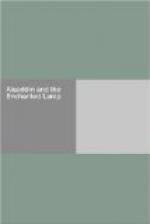It is of course evident that M. Reinaud had never read the Ms. in question nor that numbered 1723 in the Supplement Arabe, or he would at once have recognized that the latter, though not in the handwriting of the Syrian ecclesiastic, was that which served for the production of the “Sequel” in question; but, superficial as was the mistake, it sufficed to prevent the examination by students of the Ms. No. 1716 and so retarded the discovery of the Arabic originals of Aladdin and its fellows till the acquisition (some two years ago) by the Bibliotheque Nationale of another (and complete) Ms. of the Thousand and One Nights, which appears to have belonged to the celebrated Orientalist M. Caussin de Perceval, although the latter could not have been acquainted with it at the time (1806) he published his well-known edition and continuation of Galland’s translation, in the eighth and ninth volumes of which, by the by, he gives a correct version of the tales so fearfully garbled by Chavis and Cazotte in their so-called translation as well nigh to defy recognition and to cause Orientalists in general to deny the possibility of their having been derived from an Oriental source until the discovery of the actual Arabic originals so barbarously maltreated [FN#8]
This Ms. is in the handwriting of of Sebbagh, the well-known Syrian collaborator of Silvestre de Sacy, and is supposed to have been copied by him at Paris between the years 1805 and 1810 for some European Orientalist (probably de Perceval himself) from a Baghdad Ms. of the early part of the 18th century, of which it professes to be an exact reproduction, as appears from a terminal note, of which the following is a translation:
“And the finishing of it was in the first tenth (decade) of Jumada the Latter [in the] year one thousand one hundred and fifteen of the Hegira (October, 1703) in the handwriting of the neediest of the faithful [FN#9] unto God [FN#10] the Most High, Ahmed ibn Mohammed et Teradi, in the city of Baghdad, and he the Shafiy by sect and the Mosuli by birth and the Baghdadi by sojourn, and indeed he wrote it for himself and set upon it his seal, and God bless and keep our lord Mohammed and his companions! Kebikej [FN#11] (ter).”
This Ms. contains the three “interpolated” tales aforesaid, i.e. the Sleeper Awakened (Nights CCCXXXVII-LXXXVI), Zeyn Alasnam (Nights CCCCXCVII-DXIII) and Aladdin (Nights DXIV-xci), the last two bearing traces of a Syrian origin, especially Aladdin, which is written in a much commoner and looser style than Zeyn Alasnam. The two tales are evidently the work of different authors, Zeyn Alasnam being incomparably superior in style and correctness to Aladdin, which is defaced by all kinds of vulgarisms and solecisms and seems, moreover, to have been less correctly copied than the other. Nevertheless, the Sebbagh text is in every respect preferable to that of Shawish (which appears to abound in faults and errors of every kind, general and particular,) and M. Zotenberg has, therefore, exercised a wise discretion in selecting the former for publication.




